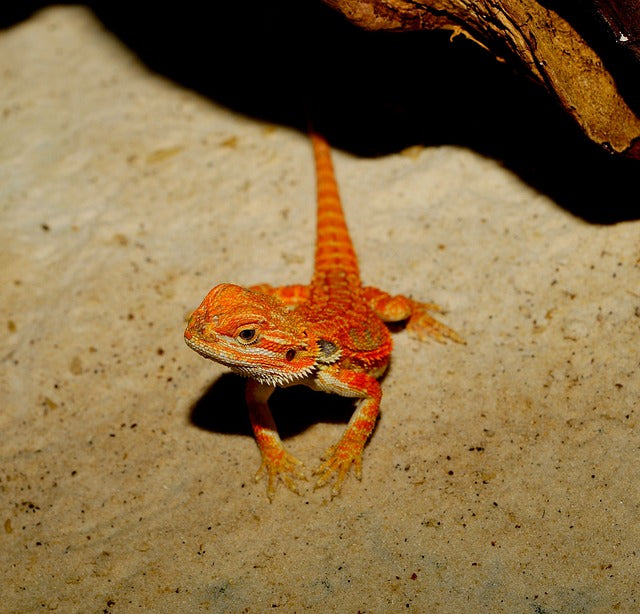Bearded Dragon (Pogona vitticeps) Care Sheet
Quick Facts
Scientific Name: Pogona vitticeps
Common Names: Bearded Dragon, Central Bearded Dragon
Origin: Central Australia
Adult Size: 40–60 cm (16–24 inches) total length
Lifespan: 8–12 years in captivity, some live up to 15 years
Sex Differences: Males have larger heads, broader beards, and more pronounced femoral pores; females are smaller, with less prominent beards and narrower bodies
Beginner Suitability: Moderate – hardy species but diet and UVB lighting require attention
Enclosure
Size: Juveniles require at least 75 cm x 45 cm x 45 cm (30 x 18 x 18 inches). Adults require 120–150 cm x 60 cm x 60 cm (4–5 ft x 2–2.5 ft x 2 ft) for optimal space.
Substrate: Use reptile carpet, paper towels, or non-toxic loose substrates for adults. Avoid sand for juveniles to prevent ingestion. Bioactive setups are possible for adults with proper monitoring.
Hides: Provide a hide on the warm side and one on the cool side. Include basking platforms, rocks, or logs for security and climbing.
Heating: Maintain a hot spot (basking area) of 35–40°C and a cool side of 24–27°C. Night temperatures can safely drop to 21–24°C. Use ceramic heat emitters or basking bulbs regulated by a thermostat.
Lighting: UVB lighting is essential. Use a 10–12% UVB tube or bulb and provide a 12-hour light / 12-hour dark cycle.
Humidity: Keep humidity between 30–40%. Provide a shallow water dish and mist lightly if necessary. Ensure good ventilation to prevent respiratory problems.
Diet
Primary Diet Type: Omnivore
Food Items: Feed gut-loaded insects such as crickets, dubia roaches, locusts, and mealworms. Offer vegetables such as collard greens, dandelion greens, mustard greens, or grated carrot. Fruits such as berries, melon, or apple can be given occasionally.
Feeding Frequency: Hatchlings should be fed daily. Juveniles 5–6 times per week. Adults every other day, focusing mainly on vegetables.
Feeding Troubleshooting: Ensure insects are appropriately sized (no larger than the width of the dragon's head). Dust food with calcium at every feeding and a multivitamin once per week. Picky eaters may need variety or different presentation.
Water
Provide a shallow, clean water dish at all times. Mist lightly if necessary for hydration.
Behavior And Handling
Bearded dragons are generally docile and tolerate handling well. Support the full body when handling. Territorial or aggressive behavior is rare. Avoid handling shortly after feeding.
Enrichment
Offer branches, rocks, and basking platforms for climbing. Include areas for digging. Occasional rearrangement of décor encourages exploration and activity.
Health
Signs of illness include lethargy, lack of appetite, swollen limbs, abnormal stool, respiratory issues such as wheezing or mucus, and retained shed, especially around toes or tail. Provide proper temperature and humidity to aid shedding. Consult a reptile-specialist veterinarian if illness persists.
Lifespan
Typically 8–12 years in captivity, though some live up to 15 years with excellent care.
Legality In The UK
Bearded Dragons are legal to keep in the UK. No licence is required for private ownership. Owners must comply with Welfare of Animals regulations.
Difficulty Bars (Relative)
| Category | Level |
|---|---|
| Feeding | ███▁▁ (Moderate) |
| Handling | █████ (Easy, tolerant and docile) |
| Humidity Needs | █▁▁▁▁ (Low) |
| Enclosure Setup | ████▁ (Moderate, UVB and basking essential) |
| Beginner Suitability | ███▁▁ (Moderate) |

